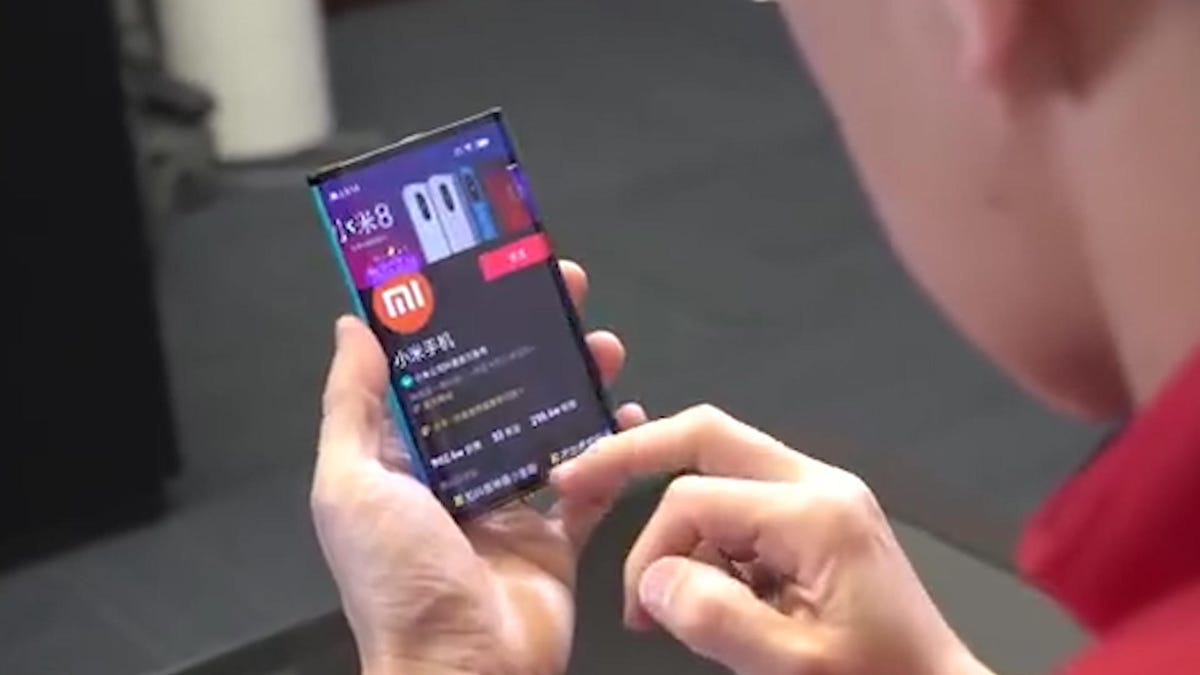Xiaomi's double-bending, foldable phone just stole Samsung's thunder
Commentary: We've never seen a foldable phone prototype like this.

Xiaomi co-founder Bin Lin posted a demo video to Chinese social platform Weibo.
Samsung is expected to show off a fully functioning version of its hotly anticipated foldable phone at its Galaxy S10 launch event on Feb. 20. But after Chinese rival brand Xiaomi teased its own book-like foldable phone on Wednesday, will people still care?
In a video posted to Weibo, China's answer to Twitter, Xiaomi co-founder and president Bin Lin plays a series of videos on a flat, rectangular device that looks like a tablet. Then he folds the right and left edges of the screen back on itself and continues using the device in typical smartphone mode.
This is novel for two reasons. It's the first time any company has seen a trifold foldable phone prototype and at first glance, this design makes a lot of sense. So far we've seen foldable phones that bend down the middle, such as the Royole FlexPai that's on sale now, and the folding Samsung prototype, a phone that's rumored to be called the Galaxy X, Galaxy F, Galaxy Fold or Galaxy Flex.
Second, Xiaomi's design is the first true challenge to Samsung's early leadership in the foldable space, a brave new design that's poised to bring the stagnant smartphone market renewed interest and growth. Industry experts agree that foldable phones won't drive enormous sales and revenue when they first appear, but that early movers can gain experience in what works and what doesn't ahead of rivals who hang back.
"History has shown that many users are on a never-ending quest for larger and larger displays and this is a technology well suited to addressing that challenge," said Ben Wood, chief researcher at CCS Insight, referring to foldable phones.
Read: Samsung's foldable phone faces 9 big issues
Xiaomi foldable phone vs. Samsung foldable phone
All phones with bendable screens face the same major challenges, including whether or not the screen can stand up to thousands of bends, and how smoothly the apps transition from the larger screen space to a smaller one.
Xiaomi's foldable phone design has an obvious inherent negative. Its screen bends in two spots, which opens up two points of potential weakness, rather than one seam on a bifold design where the foldable phone bends in half.
"Oooh," said a coworker when I showed him the video. "Now there are twice as many ways that it can break."
Its durability has yet to be tested of course, but there are key benefits that also stand out. Since the Xiaomi phone's outer edges bend backward, you're always dealing with the same central space that merely expands and contracts in size.
On the other hand, Samsung's foldable phone will have you switch between a 4.5-inch screen on the outside of the phone while it's "closed" and a 7.3-inch interior screen when it's "open." Even in the best case scenario, where your app seamlessly leaps from screen to screen, you'll still have to suspend what you're doing if you're reconfiguring the device.
Xiaomi's video also suggests that its foldable phone is fairly compact, folding into the familiar rectangular device rather than a kind of triangle that we've seen from bifolds like the Royole FlexPai. It isn't clear how big the air gap is on Xiaomi's foldable design, but it's unlikely that this foldable phone folds flat.
It also isn't clear from Bin Lin's brief demo video if the screen "ends" remain useful after you've folded them back. In one scene, the pixels were clearly lit up in the pinks and blues of the home screen wallpaper, but if Xiaomi intends to make these wings anything other than window dressing, the company's keeping it under wraps.
Bifolds like the FlexPai foldable phone won't easily close flat.
An affordable foldable phone for the rest of us?
As long as I'm speculating here, let me throw this last thing out there. Xiaomi phones are well-known for undercutting the price of Android flagship phones from Samsung, Huawei and others. For example, Xiaomi's thin Mi Mix 3 has a 6-inch display, four cameras and some enviable specs. It also sells for half the price of an iPhone XS.
If Xiaomi's foldable phone sells for significantly less than Samsung's model, it could take the role of an entry-level price for the curious and cash-strapped. However, there's a huge catch. Xiaomi phones don't always run Google services and don't sell everywhere in the world through carrier channels.
It could play out that Xiaomi's foldable phone makes foldable phones more attainable in Asia and in emerging markets, while playing the role of a second device or app developer's playground elsewhere.
Xiaomi hasn't announced when we'll be able to get our hands on the foldable phone prototype, but I'd guess it will make its move at Mobile World Congress late next month, which could takes place days after Samsung shows more of its Galaxy X or Galaxy F to the world.
Samsung and Xiaomi did not immediately respond to requests for comment.
Published: Jan. 23 at 12:48 p.m.
Update: 1:47 p.m. with additional commentary.
Update: 4:44 p.m.
Galaxy X/Galaxy F: Price, specs, rumored March release date for Samsung's foldable phone
The foldable phone revolution: Awkward, but essential

